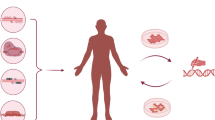We compared the efficiency of delivery of plasmid DNA (active ingredient concentration 1 mg/kg) that provides production of nerve growth factor (NGF) after intravenous administration to rats and after administration by hydroporation. The method of hydroporation ensured plasmid penetration into the liver tissue and lengthened the time of its detection in the organ. DNA concentration in 1 h after its introduction by hydroporation or intravenous route was 0.7 and 0.05 ng/mg tissue, respectively. The use of this transfection method ensured preservation of NGF DNA in the liver tissue at a level of 0.24 ng/mg of tissue 1 day after administration of the plasmid construct, while after intravenous administration, expression of the analyzed DNA was not detected in blood and liver samples. After hydroporation, the maximum of relative normalized expression of cDNA (270 rel. units) was observed after 4 h, and after 1 day, this parameter decreased to 35 rel. units. Introduction of plasmid DNA of NGF by hydroporation prevented the development of disorders of neuromuscular conduction in a rats model of toxic neuropathy induced by subacute administration of malathion in a dose of 0.5 LD50.
Similar content being viewed by others
References
Boldyreva MA, Makarevich PI, Rafieva LM, Beloglazova IB, Dergilev KV, Kostrov SV, Parfyonova YeV. Delivery of nerve growth factor (NGF) gene via recombinant plasmid vector induces angiogenesis in murine ischemic hind limb. Geny Kletki. 2014;9(4):81-87. Russian.
Zobnin YuV. Acute toxic neuropathies. Sib. Med. Zh. (Irkutsk). 2008;79(4):106-110. Russian.
Kir’yakov VA, Sukhanova AV. Predictors of the risk of occupational pathology in miners. Sanirat. Vrach. 2006;(1):60-62. Russian.
Kurushina OV, Barulin AE. Polyneuropathy in somatic diseases: the role of the neurologist in diagnosis and treatment. Russ. Med. Zh. 2013;21(36):1843-1848. Russian.
Masgutov RF, Rizvanov AA, Bogov AA Jr, Gallyamov AR, Kiyasov AP, Bogov AA. Current trends for treatment of peripheral nerves injuries. Prakt. Med. 2013;(2-2):99-103. Russian.
Mashkovskii MD. Drugs. Moscow, 2008. Russian.
Misyurin VA, Misyurin AV, Akhlynina TV, Lyzhko NA, Krutov AA, Kesaeva LA, Soldatova IN, Burova OS, Morozova LF, Mikhaylova IN, Baryshnikova MA, Baryshnikov AY, Lukina AE. Cancer-testis gene expression profile in human melanoma cell lines. Biochem. Moscow Suppl. Ser. A. 2014;8(3):240-244.
Nikolaev SG. Manual on clinical electromyography. Ivanovo, 2003. Russian.
Emergency situations of natural, technogenic, and social character and protection against them. Mikhailov LA, ed. St. Petersburg, 2008. Russian.
Bracci-Laudiero L, De Stefano ME. NGF in early embryogenesis, differentiation, and pathology in the nervous and immune systems. Curr. Top. Behav. Neurosci. 2016;29:125-152.
Grogan PM, Katz JS. Toxic neuropathies. Neurol. Clin. 2005;23(2):377-396.
Kanda T. Polyneuropathy: diagnosis and treatment. Rinsho Shienkeigaku. 2007;47(11):769-773.
Li Y, Gao J, Zhang C, Cao Z, Cheng D, Liu J, Shuai X. Stimuli- responsive polymeric nanocarriers for efficient gene delivery. Top. Curr. Chem. (Cham). 2017;375(2):27.
Tomlinson DR, Fernyhough P, Diemel LT. Neurotrophins and peripheral neuropathy. Philos. Trans. R Soc. Lond. B Biol. Sci. 1996;351:455-462.
Unger JW, Klitzsch T, Pera S, Reiter R. Nerve growth factor (NGF) and diabetic neuropathy in the rat: morphological investigations of the sural nerve, dorsal root ganglion, and spinal cord. Exp. Neurol. 1998;153(1):23-34.
Author information
Authors and Affiliations
Corresponding author
Additional information
Translated from Byulleten’ Eksperimental’noi Biologii i Meditsiny, Vol. 164, No. 12, pp. 776-780, December, 2017
Rights and permissions
About this article
Cite this article
Yudin, M.A., Bykov, V.N., Nikiforov, A.S. et al. Study of the Efficiency of the Hydroporation for Delivery of Plasmid DNA to the Cells on the Model of Toxic Neuropathy. Bull Exp Biol Med 164, 798–802 (2018). https://doi.org/10.1007/s10517-018-4083-0
Received:
Published:
Issue Date:
DOI: https://doi.org/10.1007/s10517-018-4083-0




